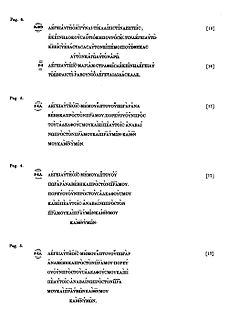| New Testament manuscript | |
| Text | Matthew 5:1-11; Luke 24:26-33 |
|---|---|
| Date | 9th century |
| Script | Greek |
| Found | Hatch, 1929 |
| Now at | National Museum of Damascus |
| Size | 18.5 x 14 cm |
| Type | unknown |
| Category | none |
Uncial 0196 (in the Gregory-Aland numbering), is a Greek uncial manuscript of the New Testament, dated paleographically to the 9th century.
The codex contains small parts of Matthew 5:1-11 and Luke 24:26-33, on two parchment leaves (18.5 cm by 14 cm), and is written in one column per page, 19 lines per page, in uncial letters. It is a palimpsest, the lower text is in Syriac, written in estrangela. [1]
The textual character of this codex is unknown. Kurt Aland the Greek text of the codex did not place in any Category. [1]
According to Hatch the manuscript was written by Egyptian or Palestinian hand.
It is dated by the Institute for New Testament Textual Research to the 9th century. [1] [2]
The manuscript was discovered in 1929 by Hatch. [3] Ernst von Dobschütz designated it by 0196.
The codex used to be housed at the National Museum of Damascus. [1] The manuscript is not accessible. [1]

Codex Zacynthius (designated by siglum Ξ or 040 in the Gregory-Aland numbering; A1 in von Soden) is a Greek New Testament codex, dated paleographically to the 6th century. First thought to have been written in the 8th century, it is a palimpsest—the original (lower) text was washed off its vellum pages and overwritten in the 12th or 13th century. The upper text of the palimpsest contains weekday Gospel lessons; the lower text contains portions of the Gospel of Luke, deciphered by biblical scholar and palaeographer Tregelles in 1861. The lower text is of most interest to scholars.

Uncial 050, Cι1, is a Greek uncial manuscript of the New Testament, written on parchment. Palaeographically it has been assigned to the 9th-century. Formerly it was labelled by O or We.
Uncial 062 ε 64 (Soden), is a Greek uncial manuscript of the New Testament on parchment, dated palaeographically to the 5th century.
Uncial 083, ε 31 (Soden), is a Greek uncial manuscript of the New Testament, dated paleographically to the 6th/7th century. The codex now is located at the Russian National Library in Saint Petersburg.
Uncial 089 in the Gregory-Aland numbering), ε 28 (Soden), is a Greek uncial manuscript of the New Testament, dated paleographically to the 6th century. The codex now is located at the Russian National Library in Saint Petersburg. It came to Russia from Sinai.
Uncial 0118, ε 62 (Soden); is a Greek uncial manuscript of the New Testament, dated paleographically to the 8th-century.
Uncial 0133, ε 83 (Soden), is a Greek uncial manuscript of the New Testament, dated paleographically to the 9th century. Formerly it was labelled by Wg.
Uncial 0144, ε 012 (Soden), is a Greek uncial manuscript of the New Testament, dated palaeographically to the 7th century.
Uncial 0163, is a Greek uncial manuscript of the New Testament, dated palaeographically to the 5th century.

Uncial 0187, ε 024 (Soden), is a Greek uncial manuscript of the New Testament, dated paleographically to the 6th century.
Uncial 0211, ε 051 (Soden), is a Greek uncial manuscript of the New Testament, dated paleographically to the 7th century.
Uncial 0237, ε 014, is a Greek-Coptic uncial manuscript of the New Testament. Paleographically it has been assigned to the 6th-century.
Uncial 0240, is a Greek uncial manuscript of the New Testament. Palaeographically it has been assigned to the 5th century.
Uncial 0258, is a Greek uncial manuscript of the New Testament. Paleographically it has been assigned to the 4th century.
Uncial 0264, is a Greek uncial manuscript of the New Testament. Paleographically it has been assigned to the 5th century.

Uncial 0269, ε 83 (Soden), is a Greek uncial manuscript of the New Testament. Paleographically it has been assigned to the 9th century.
Lectionary 3, designated siglum ℓ3, is a Greek manuscript of the New Testament on vellum. Palaeographically it has been assigned to the 11th century. Scrivener dated to the 10th century.
Lectionary 214, designated by siglum ℓ214, is a Greek manuscript of the New Testament, on parchment. Palaeographically it has been assigned to the 12th century. Scrivener labelled it by 239evl.

Lectionary 296 (Gregory-Aland), designated by siglum ℓ296 is a Greek manuscript of the New Testament, on parchment. Palaeographically it has been assigned to the 10th century. The manuscript is very lacunose.
Lectionary 1599 (Gregory-Aland), designated by siglum ℓ1599 is a Greek manuscript of the New Testament, on parchment. Palaeographically it has been assigned to the 10th or 11th century. The manuscript is lacunose. It is known as Argos Lectionary.